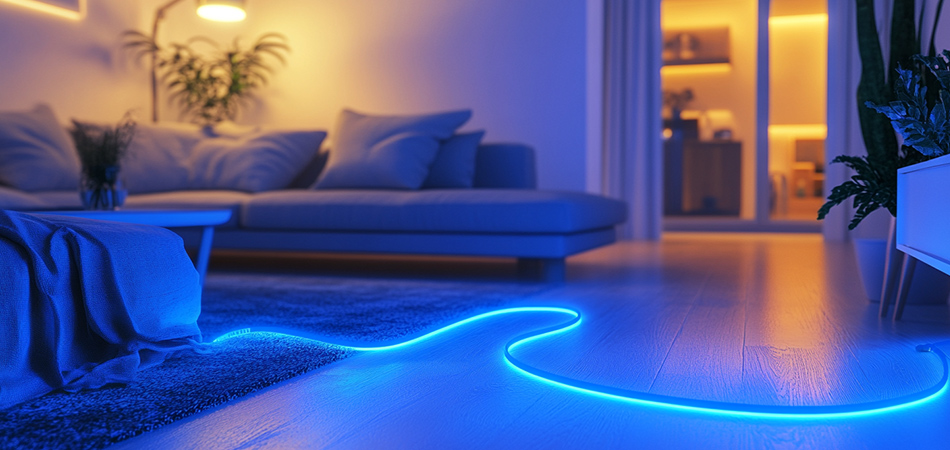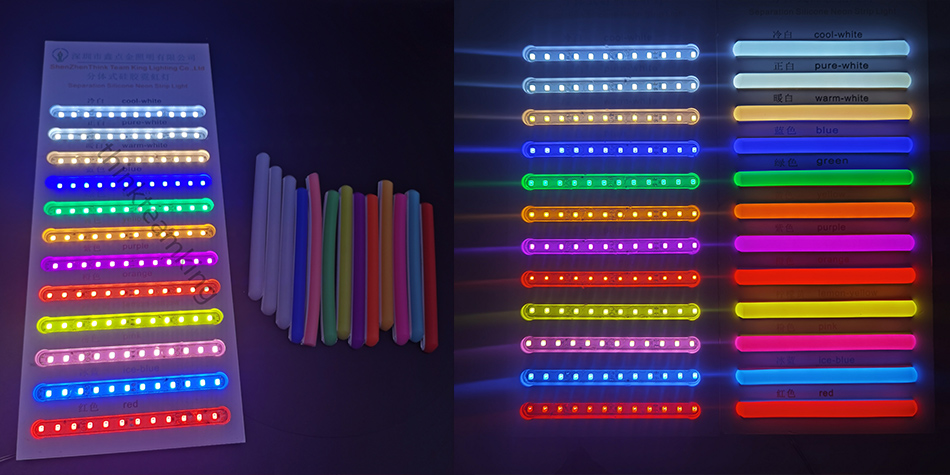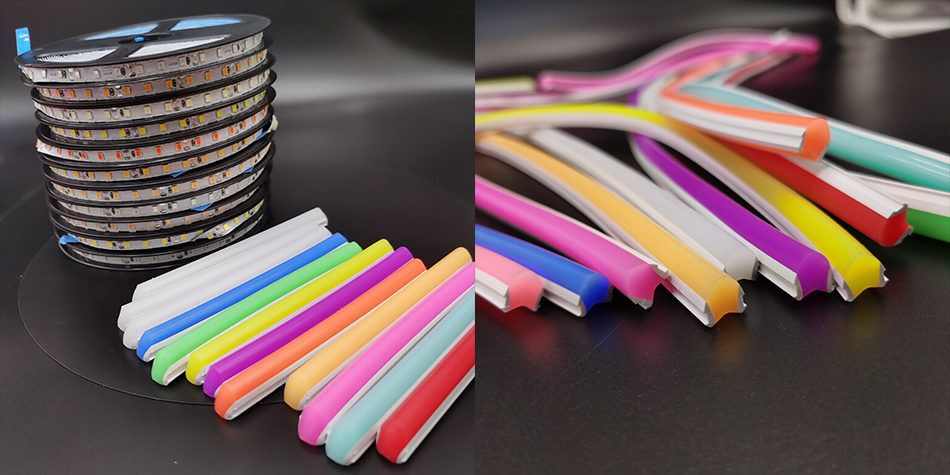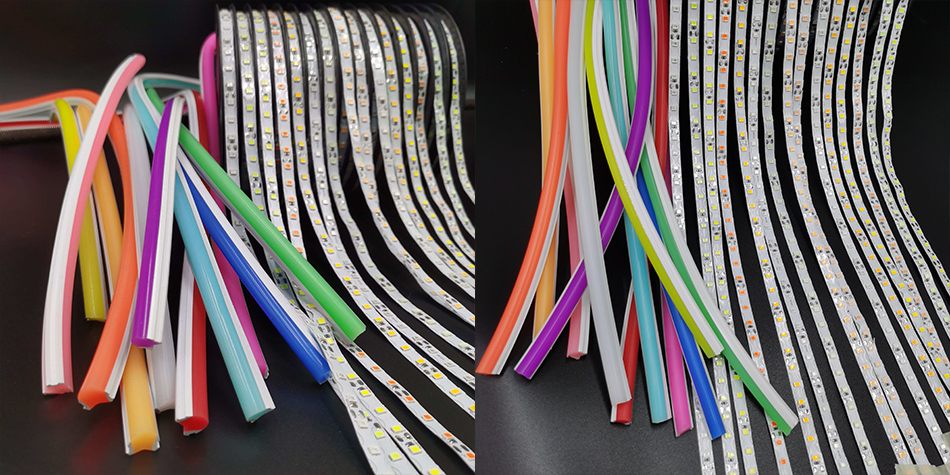Time:2025-08-12
Energy-efficient Silicone Neon Strip represents a pivotal advancement in sustainable lighting, merging the versatility of silicone neon with cutting-edge energy-saving technology. As global efforts to reduce carbon footprints intensify, these strips have emerged as a preferred choice for both residential and commercial users seeking to balance aesthetic appeal with environmental responsibility. Unlike traditional neon or even standard LED strips, energy-efficient silicone neon strips are engineered to minimize power consumption without compromising on brightness, color quality, or durability. This article explores the core technologies behind their efficiency, material innovations, performance metrics, application versatility, and environmental impact, highlighting how they are redefining the standards of modern lighting.

The energy efficiency of these silicone neon strips is rooted in a combination of advanced technologies that optimize light output while reducing power usage. High-performance LEDs are the foundation, with diodes specifically selected for their luminous efficacy—the amount of light produced per unit of energy consumed. These LEDs are designed to convert a higher percentage of electrical energy into visible light rather than heat, a key distinction from traditional incandescent or even older LED models that waste significant energy as heat. The diodes are also grouped in configurations that maximize light distribution, ensuring that fewer LEDs are needed to achieve the same brightness as less efficient strips.
Intelligent circuit design further enhances efficiency by minimizing energy loss during power conversion. The strips incorporate low-resistance conductors and optimized wiring layouts that reduce voltage drop, ensuring that electricity flows evenly through the strip with minimal waste. This design is particularly important for longer strips, where energy loss can become significant in less efficient models. Additionally, many energy-efficient silicone neon strips include built-in voltage regulation, preventing overvoltage that can waste energy and shorten LED lifespan.
Dimming and control systems play a crucial role in energy savings, allowing users to adjust brightness levels based on need. Unlike traditional neon, which operates at full brightness or not at all, these strips are compatible with dimmers and smart controls that reduce power consumption when full brightness isn’t required. Some advanced models even feature ambient light sensors, automatically dimming or brightening in response to natural light levels—for example, reducing output during daylight hours and increasing it in the evening—further optimizing energy use.
Heat management is integrated into the design to maintain efficiency over time. Excess heat can degrade LED performance and increase energy consumption, so energy-efficient silicone neon strips use heat-dissipating materials in their casings and circuit boards. This prevents thermal runaway, ensuring that the LEDs operate at their optimal temperature and maintain their energy efficiency throughout their lifespan.

The materials used in energy-efficient silicone neon strips are carefully selected to complement their energy-saving technologies, enhancing both performance and durability. Low-transmission loss silicone forms the casing, allowing maximum light output while minimizing energy waste. This silicone is engineered to be highly translucent, ensuring that light from the LEDs passes through with minimal absorption or scattering. Unlike cheaper casings that may yellow or cloud over time—reducing light output and forcing users to run the strip at higher power to compensate—this high-quality silicone maintains its clarity, preserving efficiency for years.
Lightweight, flexible circuit boards made from advanced polymers reduce energy loss through resistance. These boards are thinner and more conductive than traditional alternatives, allowing electricity to flow more freely with less power loss. Their flexibility also enables tighter LED spacing, which improves light uniformity and reduces the need for additional LEDs to achieve consistent brightness—another factor in energy efficiency.
Reflective layers integrated into the strip’s design redirect light outward, preventing waste of photons that would otherwise be absorbed by the circuit board or casing. This layer, often made from a thin, high-reflectivity material, bounces stray light back toward the surface, increasing the overall light output without increasing power consumption. This is particularly effective in applications where the strip is mounted close to a surface, such as under cabinets or behind furniture.
Eco-friendly additives in the silicone casing enhance sustainability without compromising efficiency. These include UV stabilizers that prevent degradation from sunlight (reducing the need for premature replacement) and flame-retardant compounds that eliminate the need for energy-intensive cooling systems in commercial installations. The additives are chosen for their low environmental impact, ensuring that the materials remain recyclable at the end of the strip’s lifespan.

Energy-efficient silicone neon strips are evaluated using a range of metrics that quantify their efficiency, performance, and longevity. Luminous efficacy is a key measure, expressed as lumens per watt (lm/W). High-quality energy-efficient strips achieve significantly higher efficacy than standard LED strips, meaning they produce more light for each watt of electricity consumed. This translates directly to lower energy bills, as users can achieve the desired brightness with less power.
Color rendering index (CRI) is another important metric, ensuring that energy efficiency doesn’t come at the cost of color accuracy. These strips typically have a high CRI, meaning they render colors as they appear in natural light. This is important for applications like retail displays or art lighting, where color accuracy is critical. Unlike some low-quality efficient lighting that produces harsh, unnatural colors, energy-efficient silicone neon strips maintain rich, balanced hues while using less energy.
Lifespan is closely tied to energy efficiency, as longer-lasting products reduce the energy and resources needed for manufacturing and replacement. These strips are designed to last tens of thousands of hours, with LEDs that maintain at least 70% of their initial brightness over this period (a standard known as L70). This longevity is achieved through robust materials and heat management, ensuring that the strip remains efficient throughout its lifespan.
Power factor (PF) measures how effectively the strip converts electrical power into useful work. Energy-efficient silicone neon strips have a high power factor (typically above 0.9), indicating minimal waste in the conversion process. This is particularly important for commercial applications, where low power factor can result in penalties from utility companies and increased overall energy consumption.

Energy-efficient silicone neon strips are versatile enough to enhance a wide range of spaces, delivering efficient illumination without sacrificing style or functionality. Residential applications benefit from their ability to provide ambient, task, or accent lighting with minimal energy use. In kitchens, they can be installed under cabinets to illuminate countertops, using less power than traditional under-cabinet lights while providing brighter, more uniform illumination. Bedrooms use them as nightlights or behind headboards, with dimmable features allowing users to reduce energy consumption during overnight use. Living rooms leverage their flexibility to outline bookshelves, TV units, or fireplaces, adding ambiance without increasing electricity bills.
Commercial spaces rely on these strips to balance aesthetics with operational costs. Retail stores use them to highlight merchandise in display cases or window fronts, where their high CRI ensures products appear vibrant while low power consumption reduces overhead costs. Restaurants and hotels install them in dining areas, lobbies, or outdoor patios, using dynamic color options (in RGB models) to create moods without the energy drain of traditional lighting. Office buildings use them for task lighting under desks or along hallway,providing focused illumination that reduces the need for bright overhead lights, lowering overall energy use.
Outdoor environments benefit from energy-efficient silicone neon strips designed to withstand the elements. Their weather-resistant silicone casing and low power consumption make them ideal for illuminating pathways, patio edges, or building exteriors. Unlike traditional outdoor lighting that can be energy-intensive, these strips provide consistent, durable illumination using minimal power, making them suitable for 24/7 use in security or decorative applications.
Specialized applications include areas where energy efficiency is critical, such as eco-friendly buildings, off-grid homes, or historical sites with strict energy constraints. In these settings, the strips provide necessary lighting without straining limited power sources, whether solar panels or generators. They are also used in educational facilities and healthcare settings, where their low heat output and energy efficiency contribute to a safe, sustainable environment.

The environmental benefits of energy-efficient silicone neon strips extend beyond reduced energy consumption, contributing to a more sustainable lifecycle from production to disposal. Reduced carbon emissions are a direct result of lower energy use, with each strip emitting significantly fewer greenhouse gases over its lifespan compared to traditional neon or less efficient LED strips. This aligns with global efforts to mitigate climate change, making them a preferred choice for LEED-certified buildings and eco-conscious projects.
Material sustainability is a key factor, with manufacturers using recycled and renewable materials in production. The silicone casing is often made from recycled or plant-based silicone, reducing reliance on fossil fuels. Circuit boards may incorporate recycled copper and other metals, while packaging is minimized and made from recyclable or biodegradable materials. These practices reduce the strip’s overall environmental footprint, from raw material extraction to manufacturing.
Longevity and recyclability further enhance sustainability. The strips’ long lifespan reduces the frequency of replacement, minimizing waste. At the end of their useful life, their components—silicone casing, LEDs, and metal conductors—can be separated and recycled, recovering valuable materials and preventing them from ending up in landfills. Some manufacturers even offer take-back programs, ensuring proper recycling and reducing the environmental impact of disposal.
Reduced light pollution is an additional benefit, as these strips can be directed to illuminate specific areas without spilling excess light into the environment. This is particularly important for outdoor applications, where light pollution can disrupt ecosystems and waste energy. Their focused light output ensures that energy is used only where needed, contributing to more sustainable urban and natural environments.
Proper installation and maintenance are essential to ensuring that energy-efficient silicone neon strips maintain their efficiency over time. Optimal placement minimizes the need for excessive brightness, as strategic positioning can maximize light coverage. For example, installing strips close to surfaces (like under cabinets) allows their light to reflect off the surface, increasing perceived brightness without increasing power. Avoiding obstructions that block light also ensures that the strip’s output is used effectively, reducing the need to run it at higher settings.
Correct power management prevents energy waste, with users advised to match the strip to an appropriate power supply that delivers only the necessary voltage. Overpowering the strip not only wastes energy but can also reduce its lifespan, while underpowering can result in dim, uneven light. Many energy-efficient strips come with compatible power supplies designed to maximize efficiency, and smart controllers can further optimize power use by adjusting output based on need.
Regular cleaning maintains light output and efficiency, as dust and dirt on the silicone casing can reduce light transmission, forcing users to increase brightness to compensate. A soft, dry cloth or mild cleaning solution (avoiding harsh chemicals) is sufficient to remove debris, ensuring that the strip continues to deliver maximum light with minimal energy.
Periodic inspection identifies issues that could reduce efficiency, such as loose connections, damaged casing, or dimming LEDs. Addressing these issues promptly—for example, repairing a damaged section or replacing a faulty connector—prevents the strip from working harder to compensate, maintaining its energy-saving properties.
The market for energy-efficient silicone neon strips is evolving rapidly, driven by advancing technology and growing demand for sustainable lighting. Integration with smart home systems is becoming standard, with strips connecting to IoT platforms for automated energy management. Users can program schedules, set brightness levels based on occupancy, or sync with other smart devices to optimize energy use—for example, dimming lights when a room is unoccupied or adjusting based on solar panel output.
Improved LED technology continues to enhance efficiency, with next-generation diodes offering higher efficacy and longer lifespans. These diodes produce more light with even less energy, while advances in color science ensure that energy efficiency doesn’t compromise color quality. Some manufacturers are exploring perovskite LEDs, which promise even higher efficiency and lower production costs than traditional LEDs.
Solar integration is emerging as a trend, with energy-efficient silicone neon strips paired with small solar panels for off-grid applications. This combination allows for sustainable lighting in remote areas, parks, or outdoor spaces without access to electrical grids, further reducing environmental impact.
Customizable efficiency profiles are becoming available, allowing users to select strips optimized for specific applications—whether maximum brightness with minimal energy for retail displays or low-power ambient lighting for residential use. This customization ensures that users get the right balance of performance and efficiency for their needs, avoiding over-consumption.
Energy-efficient silicone neon strips represent a significant step forward in sustainable lighting, proving that efficiency and aesthetics can coexist. By combining advanced LED technology, intelligent design, and eco-friendly materials, they deliver bright, versatile illumination while minimizing energy use and environmental impact. From homes and offices to commercial and outdoor spaces, these strips are transforming how we light our world—making it more sustainable, cost-effective, and visually appealing.
As technology continues to advance, their efficiency will only improve, with new innovations further reducing energy consumption and expanding their applications. For users seeking to reduce their carbon footprint without sacrificing style, energy-efficient silicone neon strips are more than a lighting choice—they are a commitment to a more sustainable future, one illuminated space at a time.